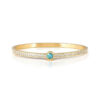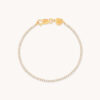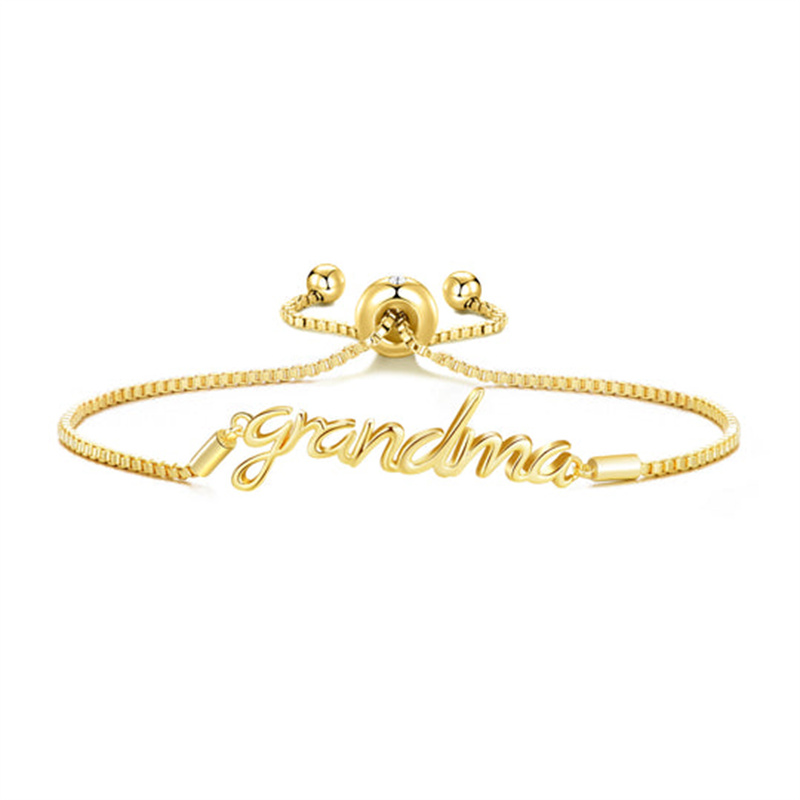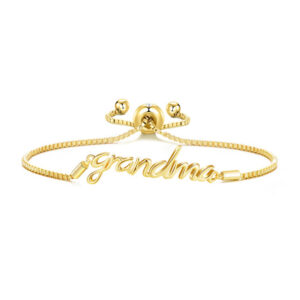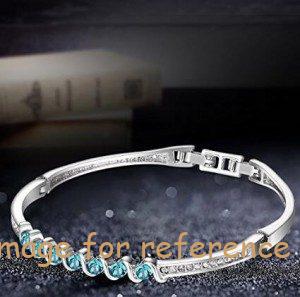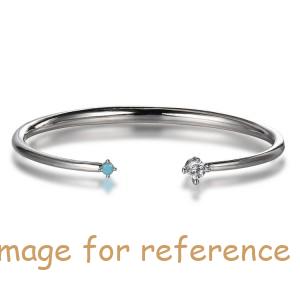ジンジー:ゴールドメッキレターブレスレットOEM ODMジュエリーメーカー
OEM/ODMジュエリーメーカーのデザインカスタム独自のジュエリー
始めましょう : mo@kingjy.com
ジンジー: パーソナライゼーションの芸術 – An OEM/ODM Gold Plated Letter Bracelet Manufacturing Journey
In the vibrant and ever-evolving landscape of fashion jewelry, few items possess the unique power of the letter bracelet. It is a piece that transcends mere adornment, becoming a canvas for identity, connection, and personal narrative. Whether it spells out a name, a meaningful word, an initial, or a secret message, it carries a story on the wrist. For brands looking to capitalize on this profound trend, the journey from a spark of an idea to a shelf-ready product is expertly facilitated by a specialized OEM/ODM jewelry manufacturer.
The Chinese term “ジンジー” (仕事) embodies the concepts of operation, 管理, and meticulous cultivation. ある “ジンジー” manufacturer does not merely assemble products; it cultivates partnerships, manages complex supply chains, and operates with a philosophy of continuous improvement and client-centric service. この記事では、徹底的な情報を提供します, behind-the-scenes exploration of the OEM (オリジナルの機器メーカー) およびODM (オリジナルのデザインメーカー) processes for creating a custom gold-plated letter bracelet. We will dissect every stage, from the initial concept to the final packaged product, revealing the intricate blend of technology, 芸術性, and strategic management that defines this manufacturing niche.
段階 1: 基礎 – OEM対. ODM and the Initial Partnership
Understanding the distinction between OEM and ODM is crucial, as it defines the nature of the client-manufacturer relationship from the outset.
OEM (オリジナルの機器製造): The Client’s Blueprint
In an OEM model, the client comes to the manufacturer with a fully or largely developed design. They provide detailed specifications, 技術図面, or even a physical sample. The manufacturer’s role is to execute this design precisely, sourcing materials and managing production according to the client’s explicit instructions. For a letter bracelet, this could mean a brand providing the exact font file for the letters, the precise dimensions of the chain links, and the specific type of gold plating required.
ODM (オリジナルのデザイン製造): The Manufacturer’s Innovation
In an ODM model, the client leverages the manufacturer’s existing design expertise, r&D capabilities, and product libraries. A brand might approach the manufacturer with a market need—”we want a line of trendy, dainty letter bracelets for young adults”—and the manufacturer will present a range of pre-designed options for customization. The client can then select a base model, modify it (例えば。, change the chain style, the font of the letters, or the clasp), and brand it as their own. This is a far more collaborative and efficient model for clients who may not have in-house design resources.
ステップ 1: The Initial Consultation & Project Scoping
The process begins with a deep-dive conversation to align vision with feasibility.
-
Client Vision: Is the client an OEM partner with rigid specifications, or an ODM partner seeking creative input?
-
ブレスレットスタイル: 主な考慮事項は次のとおりです。:
-
Letter Form: Are the letters individual charms hanging from a chain? Are they interconnected links that form a word? Are they stamped onto a flat bar?
-
チェーンタイプ: A delicate cable chain, a sturdy rope chain, a trendy snake chain, or a box chain? The choice impacts the bracelet’s style, 耐久性, そして感じる.
-
中留機構: A simple spring ring clasp, a secure lobster clasp, a decorative toggle clasp, or a sophisticated box clasp with a safety latch?
-
-
材料仕様:
-
ベースメタル: This is the core material that will be plated. The most common choices are:
-
真鍮: The industry standard for gold-plated jewelry. It’s affordable, 耐久性, and takes plating exceptionally well.
-
銅: Also an excellent base for plating, offering a very smooth surface, but softer than brass.
-
ステンレス鋼: プレミアム, 低刺激性, and extremely durable base. Gold plating over stainless steel (often called gold IP, or Ion Plating) is more wear-resistant but also more expensive.
-
-
メッキの仕様: The type and quality of the gold layer.
-
メッキの厚さ: ミクロンで測定 (例えば。, 0.5 ミクロン, 1 ミクロン, 3 ミクロン). A thicker plating lasts longer and is more resistant to tarnishing. The industry often refers to this as “Heavy Gold Plating.”
-
Plating Color: イエローゴールド, ローズゴールド (an alloy of gold and copper), or white gold (an alloy of gold plated with rhodium for a bright white finish).
-
メッキ型: Standard electroplating is common. For higher-end pieces, IP (イオンメッキ) or PVD (物理的な蒸気堆積) create a more bonded, 耐久性, and scratch-resistant surface.
-
-
-
注文量 & Target Price: The manufacturer must understand the budget and quantity, as this dictates the manufacturing techniques. A order of 50,000 units allows for different tooling and processes than a custom order of 500 作品.
段階 2: The Design and Engineering Blueprint
This phase transforms the conceptual into the technical.
ステップ 2: デザインの最終化 & CADモデリング
Whether working from a client’s OEM design or developing an ODM concept, the process culminates in a precise digital model.
-
Font Selection & ベクトル化: For letter bracelets, typography is everything. The design team either uses the client’s provided font file or selects an appropriate one from their library (ensuring licensing compliance). Each letter is converted into a clean, manufacturable vector path.
-
3D CADモデリング: Using specialized jewelry CAD software (like Rhino Gold or Matrix), a designer creates a three-dimensional model of the entire bracelet.
-
Letter Geometry: The model defines the thickness, 深さ, and any decorative bevels or edges on the letters.
-
鎖 & Link Engineering: Each link of the chain is modeled to ensure smooth movement and structural integrity. For interconnected letter bracelets, the connection points between each letter are engineered to be both flexible and strong.
-
Clasp Integration: The clasp is modeled and integrated seamlessly into the bracelet’s design.
-
-
Virtual Prototyping & Rendering: The CAD model allows for virtual assembly and photorealistic rendering. The client can see the bracelet from all angles, in different gold colors, and often in a “virtual try-on” シナリオ. This is the stage for final approvals and adjustments before any physical cost is incurred.
ステップ 3: 引用 & Project Finalization
完成したCADモデルを使用, the factory can generate an accurate and detailed quotation.
-
コスト内訳:
-
Base Metal Cost: Calculated from the volume of the CAD model.
-
メッキコスト: Based on the surface area and the specified plating thickness and type.
-
ツーリング/金型コスト: The one-time cost for creating casting molds or stamping dies.
-
人件費: Encompassing sampling, 鋳造, 組み立て, 研磨, メッキ, および品質管理.
-
パッケージングコスト.
-
-
Timeline Agreement: A production schedule is established, outlining key milestones from sampling to final delivery.
-
Contract Signing: A formal agreement is signed, すべての仕様をロックする, 費用, タイムライン, and terms of quality.
段階 3: The Prototyping Stage – A Physical Reality
ステップ 4: Sample Making – The “First Article”
A physical sample is created to validate the design, 感じる, そして品質.
-
3D印刷 (迅速なプロトタイピング): CADファイルは高解像度3Dプリンターに送信されます, which creates a resin model of the bracelet. This is a fast and accurate way to check the form, the font clarity, and the overall proportions.
-
サンプル鋳造 & 組み立て: The resin model is used to create a master mold, and a small batch of samples is cast in the specified base metal (例えば。, 真鍮). These samples are then hand-finished, assembled, and plated to the agreed standard.
-
The “Gold Sample”: This finished sample, mirroring the final production piece, is sent to the client for approval.
ステップ 5: Sample Evaluation & 承認
The client conducts a rigorous evaluation of the sample:
-
設計の忠実性: Does the font look correct? Is the size and proportion as expected?
-
快適さと摩耗性: How does it feel on the wrist? Is the clasp easy to operate?
-
Finish and Plating Quality: Is the color of the gold plating correct? Is the surface smooth and brilliant?
-
Durability Check: Are the connection points secure? Does the chain feel strong?
Client feedback is incorporated, そして必要に応じて, a second pre-production sample is made until full approval is granted.
段階 4: 量産 – The Symphony of Craftsmanship
承認済みサンプル付き, 工場は本格的な生産に移行します.
ステップ 6: ツーリング & Component Manufacturing
The method of manufacturing depends on the design complexity and order volume.
-
鋳造 (複雑なデザイン用): The most common method for detailed letter charms and complex chain links.
-
金型作り: A master metal model is created from the approved sample. This master is used to create rubber molds.
-
Wax Tree Injection & 投資: Wax replicas are injected into the molds and assembled onto a “木。” The tree is then placed in a flask and surrounded by a plaster investment.
-
燃え尽き症候群 & 鋳造: フラスコは加熱されます, melting the wax away (the “ロストワックス” 方法). Molten brass is then centrifugal-cast into the hollow cavities.
-
デザイン: 冷やしたら, the plaster is broken away, revealing a tree of raw brass bracelet components.
-
-
スタンピング (for simpler, flatter designs): For basic letter charms or bar bracelets, metal stamping dies are created. A powerful press stamps the letters out of a sheet of brass, which is a very fast and cost-effective method for high volumes.
ステップ 7: Pre-Assembly Finishing
The raw cast or stamped components are rough and require extensive cleaning and finishing.
-
枝抜き: The cast components are carefully cut from the casting tree.
-
Tumbling/Vibratory Finishing: The components are placed in large tumbling machines with abrasive media, 水, and compound. このプロセス, それは何時間も続く可能性があります, removes casting imperfections, smooths edges, and work-hardens the metal, giving it a preliminary shine.
ステップ 8: 組み立て & はんだ
This is a critical stage where the bracelet takes its final form.
-
Chain Assembly: For charm bracelets, the letters and other charms are linked onto the pre-made chain. For interconnected letter bracelets, each letter is meticulously linked to the next by a skilled assembler, often using micro-tweezers under magnification.
-
はんだ: Any permanent connections, such as attaching jump rings that are meant to be closed or fixing the clasp to the chain ends, are done through soldering. A jeweler uses a small torch and solder to create a strong, seamless bond. This requires great skill to avoid melting the delicate components or discoloring the metal.
ステップ 9: 研磨 & 表面の精製
To achieve a flawless surface for plating, the assembled bracelets undergo meticulous polishing.
-
機械研磨: The bracelets are polished on motorized wheels with various types of brushes and polishing compounds (ルージュ). This step brings out a high-gloss, mirror-like shine on the brass.
-
ハンド研磨: For intricate areas around the letters and chain links that machines cannot reach, experienced polishers perform detailed hand-polishing.
ステップ 10: 電気めっき – The Golden Transformation
This is the step that gives the bracelet its luxurious final appearance.
-
超音波クリーニング: The polished bracelets are thoroughly cleaned to remove all traces of polishing compound, oil, and dust. Any contamination will cause plating failure.
-
Electro-Cleaning: The bracelets are submerged in an electrochemical bath to ensure a perfectly pristine surface at a microscopic level.
-
すすぎ: Multiple rinses in deionized water remove all cleaning solutions.
-
メッキバス: The bracelets are immersed in the gold plating solution (electrolyte). They are connected to the cathode (negative terminal) of a rectifier, while a pure gold anode (positive terminal) is also placed in the solution.
-
Applying Current: 溶液に電流を流す, causing gold ions to dissolve from the anode and bond uniformly to the surface of the bracelet (cathode).
-
Process Control: The thickness of the plating is precisely controlled by the duration of the immersion and the amperage of the current. のために “heavy gold plating,” the bracelet remains in the bath for a longer period.
-
沈着後のすすぎ & Neutralization: メッキ後, the bracelets are rinsed again and often treated in a neutralization bath to stabilize the plating layer.
-
Optional Top Coat: For increased tarnish resistance, a clear, 変色防止保護コーティング (like EPXY) may be applied.
段階 5: The Final Countdown – 品質, ブランディング, と配達
ある “ジンジー” manufacturer distinguishes itself through an uncompromising quality control regime.
ステップ 11: Rigorous Quality Assurance
Every single bracelet is inspected against a multi-point checklist:
-
メッキの品質: 色の一貫性をチェックする, カバレッジ (no missed spots), and absence of peeling, 泡立つ, または変色.
-
Surface Defects: Inspection for scratches, ピット, or polishing marks that were missed.
-
構造的完全性: Tug-testing the chain and connections to ensure they are secure. Checking that soldered points are smooth and strong.
-
クラスプ機能: Testing the clasp repeatedly to ensure it opens, closes, and locks reliably.
-
寸法 & Spelling Check: Verifying the length and, most critically, ensuring the letters are correct and the word is spelled properly—a non-negotiable step for a letter bracelet.
ステップ 12: レーザー彫刻 & ブランディング
This is where the client’s brand identity is permanently etched onto the product.
-
Brand Logo/Name: The client’s logo or brand name is laser-engraved onto the clasp or a discrete part of the bracelet.
-
Material Marking: Hallmarks like “GP” (金メッキ) or the base metal (例えば。, “真鍮”) can be added.
ステップ 13: 最終的なクリーニング & パッケージング
The approved bracelets undergo a final ultrasonic clean and steam blast to remove any fingerprints or dust from the QC process. They are then carefully placed in their individual packaging—be it a branded polybag, ベルベットのポーチ, or a custom-printed gift box, ready for the retail environment.
ステップ 14: ロジスティクス & アフターセールスサポート
The factory manages the final leg of the journey: efficient packing, customs documentation, and shipping via the agreed-upon method. A reliable manufacturer also provides after-sales support, handling any inquiries and facilitating smooth re-orders.
結論: The Cultivation of Meaning
The journey of a gold-plated letter bracelet from a concept to a consumer’s wrist is a profound example of modern manufacturing “ジンイン。” It is a process meticulously managed and cultivated, blending digital precision with artisanal skill. ブランドのために, whether engaging in OEM or ODM, this partnership is strategic. It provides access to sophisticated manufacturing capabilities, 厳格な品質管理, およびスケーラブルな生産, all while allowing the brand to focus on its core competency: marketing and storytelling.
The final product is more than just gold-plated brass; it is a vessel of personal identity. It represents a successful collaboration, a managed process, and a tangible piece of a brand’s promise to its customers. In the world of personalized jewelry, the “ジンジー” manufacturer is the silent, expert partner that makes meaningful connection possible, one letter at a time.

